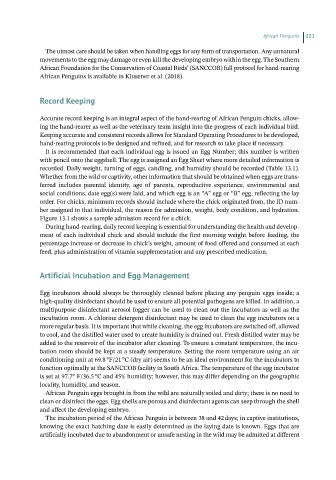Page 233 - Hand rearing birds second
P. 233
African Penguins 221
The utmost care should be taken when handling eggs for any form of transportation. Any unnatural
movements to the egg may damage or even kill the developing embryo within the egg. The Southern
African Foundation for the Conservation of Coastal Birds’ (SANCCOB) full protocol for hand‐rearing
African Penguins is available in Klusener et al. (2018).
Record Keeping
Accurate record keeping is an integral aspect of the hand‐rearing of African Penguin chicks, allow-
ing the hand‐rearer as well as the veterinary team insight into the progress of each individual bird.
Keeping accurate and consistent records allows for Standard Operating Procedures to be developed,
hand‐rearing protocols to be designed and refined, and for research to take place if necessary.
It is recommended that each individual egg is issued an Egg Number; this number is written
with pencil onto the eggshell. The egg is assigned an Egg Sheet where more detailed information is
recorded. Daily weight, turning of eggs, candling, and humidity should be recorded (Table 13.1).
Whether from the wild or captivity, other information that should be obtained when eggs are trans-
ferred includes parental identity, age of parents, reproductive experience, environmental and
social conditions, date egg(s) were laid, and which egg is an “A” egg or “B” egg, reflecting the lay
order. For chicks, minimum records should include where the chick originated from, the ID num-
ber assigned to that individual, the reason for admission, weight, body condition, and hydration.
Figure 13.1 shows a sample admission record for a chick.
During hand‐rearing, daily record keeping is essential for understanding the health and develop-
ment of each individual chick and should include the first morning weight before feeding, the
percentage increase or decrease in chick’s weight, amount of food offered and consumed at each
feed, plus administration of vitamin supplementation and any prescribed medication.
ArtificialIncubationand EggManagement
Egg incubators should always be thoroughly cleaned before placing any penguin eggs inside; a
high‐quality disinfectant should be used to ensure all potential pathogens are killed. In addition, a
multipurpose disinfectant aerosol fogger can be used to clean out the incubators as well as the
incubation room. A chlorine detergent disinfectant may be used to clean the egg incubators on a
more regular basis. It is important that while cleaning, the egg incubators are switched off, allowed
to cool, and the distilled water used to create humidity is drained out. Fresh distilled water may be
added to the reservoir of the incubator after cleaning. To ensure a constant temperature, the incu-
bation room should be kept at a steady temperature. Setting the room temperature using an air
conditioning unit at 69.8 °F/21 °C (dry air) seems to be an ideal environment for the incubators to
function optimally at the SANCCOB facility in South Africa. The temperature of the egg incubator
is set at 97.7° F/36.5 °C and 45% humidity; however, this may differ depending on the geographic
locality, humidity, and season.
African Penguin eggs brought in from the wild are naturally soiled and dirty; there is no need to
clean or disinfect the eggs. Egg shells are porous and disinfectant agents can seep through the shell
and affect the developing embryo.
The incubation period of the African Penguin is between 38 and 42 days; in captive institutions,
knowing the exact hatching date is easily determined as the laying date is known. Eggs that are
artificially incubated due to abandonment or unsafe nesting in the wild may be admitted at different

